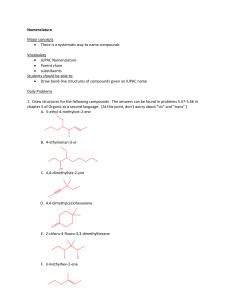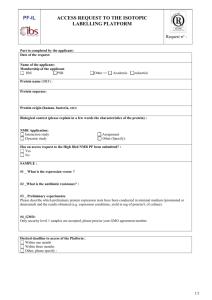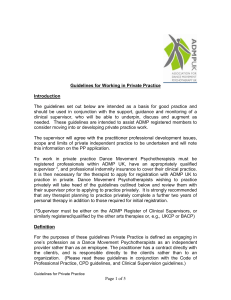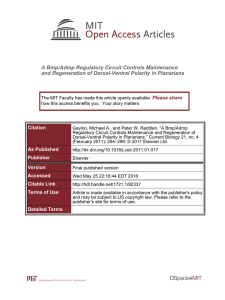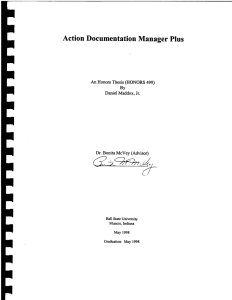here - Indiana University
advertisement
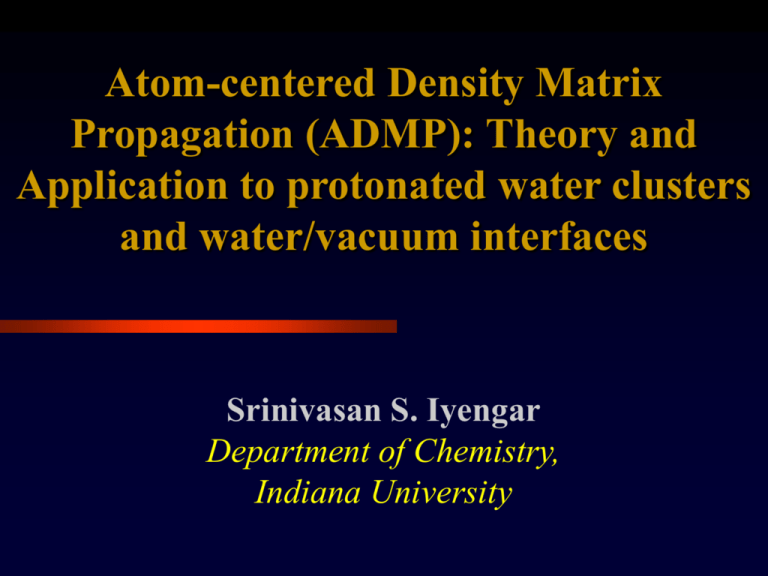
Atom-centered Density Matrix
Propagation (ADMP): Theory and
Application to protonated water clusters
and water/vacuum interfaces
Srinivasan S. Iyengar
Department of Chemistry,
Indiana University
This presentation is meant to be a quick outline of ADMP. You
should read the related papers to get more complete
understanding
Brief
outline of ab initio molecular dynamics
Atom-centered Density Matrix Propagation
(ADMP)
Results:
• Novel findings for protonated water clusters
• Preliminary results for ion-transport through
biological channels
Nut-n-bolts
issues
Molecular dynamics in Chemistry
Molecular motion
and structure determine
properties:
• Spectroscopic properties
• Predicting Molecular Reactivity
Computationally molecular dynamics
simulates
molecular motions:
• determine properties from correlation functions
• To Simulate molecular motions:
– Need Energy of conformation
– Forces to move nuclei: Simulate nuclear motion
Methods for molecular dynamics
on a single potential surface
Parameterized force fields (e.g. AMBER, CHARMM)
•
•
•
Energy, forces: parameters obtained from experiment
Molecules moved: Newton’s laws
Works for large systems
– But hard to parameterize bond-breaking/formation (chemical
reactions)
– Issues with polarization/charge transfer/dynamical effects
Born-Oppenheimer (BO) Dynamics
•
•
•
Solve electronic Schrödinger eqn within some
approximation for each nuclear structure
Nuclei are propagated using gradients (forces)
Works for bond-breaking but computationally expensive
Large reactive, polarizable systems: We need
something like BO, but less expensive.
Atom-centered Density Matrix Propagation
(ADMP) : An Extended Lagrangian approach
Circumvent
Computational Bottleneck of BO
repeated SCF for electronic SE
electronic structure, not converged, but
propagated
“Simultaneous” propagation of electronic
structure with nuclei: an adjustment of timescales
Avoid
Atom-centered Density Matrix
Propagation (ADMP)
Construct a classical phase-space {{R,V,M},{P,W,m}}
The Lagrangian (= Kinetic minus Potential energy)
1
1
T
L Tr V MV Tr μ1/4Wμ1/4
2
2
2
Nuclear KE
“Fictitious”
KE of P
Energy
functional
E(R, P) Tr Λ P 2 P
Lagrangian Constraint
for N-representability
of P: Idempotency and
Particle number
P : represented using atom-centered gaussian basis sets
Euler-Lagrange equations of motion
Equations of motion for density matrix and nuclei
“Fictitious”
mass of P
acceleration of
density matrix, P
d 2P
dt 2
μ
d 2R
M 2
dt
1/ 2
E
1/ 2
P P μ
P R
E
R
Force on P
P
Classical dynamics in {{R,V,M},{P,W,m}} phase space
Solutions obtained using velocity Verlet integrator
m effects an adjustment of time-scales:
Direction of Increasing Frequency
of m : P changes slower with time:
characteristic frequency adjusted
But Careful - too large m: non-physical
Appropriate m: approximate BO dynamics
Consequence
Bounds for m: From a Hamiltonian formalism
m: also related to deviations from the BO surface
“Physical” interpretation of m :
Commutator of
the electronic Hamiltonian
and density matrix: bounded by magnitude of
m
F, P F
1
1/4
1/4 2
Tr μ Wμ
P, W F
Magnitude of
m : represents deviation from
BO surface
m acts as an “adiabatic control parameter”
Bounds on the magnitude of m
The
Lagrangian
1
1
T
L Tr V MV Tr μ1/4Wμ1/4
2
2
E(R, P) Tr ΛP
2
2
P
The Conjugate Hamiltonian (Legendre Transform)
1
1
T
H Tr V MV Tr μ1/4Wμ1/4
2
2
H H real H fict
:
E(R, P) Tr ΛP
2
2
P
dH real
dH fict
1/2 dW 1/2
Tr Wμ
μ
dt
dt
dt
By controlling m: control deviations from BO
surface and adiabaticity
Nuclear Forces: What Really makes it work
Hellman-Feynman
contributions
E(R i , Pi )
R
P
dh ~ 1 dG ~ E xc VNN
Tr
P
P
2 dR R
R
dR
~
Tr P, F
Pulay’s moving
basis terms
~ dS ~
Tr FP
P
dR
~ dU 1 ~ T dU T
Q
U - PU
dR
dR
Contributions due to [F,P] 0. Part of
non-Hellman-Feynman
S=UTU,
Cholesky or
Löwdin
Some Advantages of ADMP
ADMP:
– Currently 3-4 times faster
than BO dynamics
– Improvements will allow
ADMP ~ 10 times faster
– Computational scaling O(N)
– Hybrid functionals (more
accurate) : routine
– Smaller m : Greater
adiabatic control
– QM/MM: localized bases:
natural
Comparison with BO dynamics
Born-Oppenheimer
dynamics:
• Converged electronic
ADMP:
• Electronic state
states.
• Approx. 8-12 SCF
•
cycles / nuclear config.
dE/dR not same in
both methods
•
•
propagated classically :
no convergence reqd.
1 SCF cycle : for Fock
matrix -> dE/dP
Current: 3-4 times faster.
10 times
Reference…
H. B. Schlegel, S. S. Iyengar, X. Li, J. M. Millam, G. A. Voth, G. E. Scuseria, M. J. Frisch, JCP, In Press.
Comparison with Car-Parrinello : Slide 0
Atom-centered Density Matrix Propagation
(ADMP) approach using Gaussian basis sets
•
•
Atom-centered Gaussian basis functions
– Fewer basis functions for molecular systems
Electronic Density Matrix propagated
– Asymptotic linear-scaling with system size
Car-Parrinello (CP) method
•
•
Orbitals expanded in plane waves
Occupied orbital coefficients propagated
– O(N3) computational scaling
References…
CP: R. Car, M. Parrinello, Phys. Rev. Lett. 55 (22), 2471 (1985).
ADMP:
H. B. Schlegel, J. Millam, S. S. Iyengar, G. A. Voth, A. D. Daniels, G. E. Scuseria, M. J. Frisch, JCP, 114, 9758 (2001).
S. S. Iyengar, H. B. Schlegel, J. Millam, G. A. Voth, G. E. Scuseria, M. J. Frisch, JCP, 115,10291 (2001).
Comparison with Car-Parrinello : Slide 1
Plane-wave CP:
ADMP:
• Computational scaling O(N3)
• Pure functionals (e.g. BLYP)
– Computational scaling O(N)
Hybrid (B3LYP): expensive
Adiabatic control limited :
larger m : D2O for H2O
Properties depend on m §
accurate) : routine
– Smaller m : Greater adiabatic
control: can use H2O
– Properties independent of m #
•
•
– Hybrid functionals (more
References…
§ Scandolo and Tangney, JCP. 116, 14 (2002).
# Schlegel, Iyengar, Li, Millam, Voth, Scuseria, Frisch, JCP, 117, 8694 (2002).
Comparison with Car-Parrinello : Slide 2
Plane-wave CP:
• Larger no. of basis fns.
• QM/MM: Plane-waves
•
enter MM region
Pseudopotentials
required for core
ADMP:
• Fewer basis fns.
• QM/MM: localized
•
bases: natural
Pseudopotentials not
required for core
– Important for metals
e.g., redox species and
enzyme active sites
Propagation of P: a time-reversible
propagation scheme
Velocity Verlet propagation of P
1/ 2
t 2 1/ 2 E(R i , Pi )
Pi 1 Pi Wi t μ
i Pi Pi i i μ
2
Pi
R
Propagation of W
1/ 2
t 1/ 2 E(R i , Pi )
Wi 1/2 Wi - μ
i Pi Pi i i μ
2
R
Pi
1/ 2
t 1/ 2 E(R i 1 , Pi 1 )
Wi 1 Wi 1/2 - μ
i 1Pi 1 Pi 1 i 1 i 1 μ
2
Pi 1
R
Classical dynamics in {{R,V},{P,W}} phase space
i and i+1 obtained iteratively:
– Conditions: Pi+1 2 = Pi+1 and WiPi + PiWi = Wi
Idempotency: To obtain Pi+1
Given Pi2 = Pi, need to find indempotent Pi+1
Guess:
t 2 1/ 2 E(R i , Pi ) 1/ 2
*
Pi 1 Pi Wi t -
2
μ
Pi
μ
R
Or guess: Pi1* Pi 2Wi t - Wi-1/2 t
Iterate Pi+1 to satisfy Pi+12 = Pi+1
Pi 1 Pi 1 μ 1/ 2 Pi TPi Qi TQ i μ 1/ 2
~
*
T μ1/ 2 Pi 1 Pi 1 μ1/ 2
*
Rational for choice PiTPi + QiTQi above:
i Pi Pi i i Pi i Pi Qi i Qi
Idempotency: To obtain Wi+1
Given WiPi + PiWi = Wi, find appropriate Wi+1
Guess:
*
i 1
W
t 1/ 2 E(R i 1 , Pi 1 ) 1/ 2
Wi 1/2 - μ
μ
2
Pi 1
R
Wi 1 W
*
i 1
μ
1/ 2
~
~
Pi 1TPi 1 Qi 1TQi 1 μ 1/ 2
~
~
*
T μ1/ 2 Wi 1 Wi 1 μ1/ 2
Iterate Wi+1 to satisfy Wi+1Pi+1 + Pi+1Wi+1 = Wi+1
Density Matrix Forces:
McWeeny Purified DM (3P2-2P3) in
energy expression to obtain
Use
E(R i , Pi )
3FP 3PF 2FP2 2PFP 2P 2 F
P
R
Nuclear Forces: What Really makes it work
Hellman-Feynman
contributions
E(R i , Pi )
R
P
dh ~ 1 dG ~ E xc VNN
Tr
P
P
2 dR R
R
dR
~
Tr P, F
Pulay’s moving
basis terms
~ dS ~
Tr FP
P
dR
~ dU 1 ~ T dU T
Q
U - PU
dR
dR
Contributions due to [F,P] 0. Part of
non-Hellman-Feynman
S=UTU,
Cholesky or
Löwdin
Idempotency (N-Representibility of DM):
Given
Pi2 = Pi, need i to find idempotent
Pi+1
Solve iteratively: Pi+12 = Pi+1
Given Pi, Pi+1, Wi, Wi+1/2, need i+1 to find
Wi+1
Solve iteratively: Wi+1 Pi+1 + Pi+1 Wi+1 =
Wi+1
How it all works …
Initial
config.: R(0). Converged SCF: P(0)
Initial velocities V(0) and W(0) : flexible
P(t), W(t) : from analytical gradients and
idempotency
Similarly for R(t)
And the loop continues…
Results
For Comparison
with Born-Oppenheimer
dynamics
• Formaldehyde photo-dissociation
• Glyoxal photo-dissociation
New
Results for Protonated Water clusters
Protonated water wire
Ion transport through gramicidin ion channels
Protonated Water Clusters
Important systems for:
• Ion transport in biological and condensed systems
• Enzyme kinetics
• Acidic water clusters: Atmospheric interest
• Electrochemistry
Experimental work:
• Mass Spec.: Castleman
• IR: M. A. Johnson, M. Okumura
• Sum Frequency Generation (SFG) : Y. R. Shen, M. J. Schultz
and coworkers
Variety of medium-sized protonated clusters using
ADMP
Protonated Water Clusters: Hopping
via the Grotthuss mechanism
True for 20,
30, 40, 50
and larger
clusters…
(H2O)20H3O+: Magic number cluster
Hydronium goes to surface: 150K, 200K and 300K:
B3LYP/6-31+G** and BPBE/6-31+G**
Castleman’s experimental
results:
• 10 “dangling” hydrogens
in cluster
•
– Found by absorption of
trimethylamine (TMA)
10 “dangling” hydrogens:
consistent with our ADMP
simulations
But: hydronium on the
surface
Larger Clusters and water/vacuum
interfaces: Similar results
Predicting New Chemistry: Theoretically
A Quanlitative explanation to the remarkable Sum Frequency
Generation (SFG) of Y. R. Shen, M. J. Schultz and coworkers
Protonated Water Cluster: Conceptual
Reasons for “hopping” to surface
Hydrophobic and hydrophillic regions: Directional hydrophobicity
(it is amphiphilic)
H3O+ has reduced density around
Reduction of entropy of surrounding waters
Is Hydronium hydrophobic ?
H2O coordination 4
H3O+ coordination =3
Spectroscopy: A recent quandry
Water Clusters: Important in Atmospheric Chemistry
Bottom-right spectrum
From ADMP agrees
well with expt:
dynamical effects in IR
spectroscopy
Explains the experiments of M. A. Johnson
Experimental results seem to suggest this
as well
Y. R. Shen: Sum Frequency Generation (SFG)
• IR for water/vapor interface shows dangling O-H bonds
• intensity substantially diminishes as acid conc. is increased
• Consistent with our results
– Hydronium on surface: lone pair outwards, instead of dangling O-H
•
acid concentration is higher on the surface
Schultz and coworkers: acidic moieties alter the
structure of water/vapor interfaces
References…
P. B. Miranda and Y. R. Shen, J. Phys. Chem. B, 103, 3292-3307 (1999).
M. J. Schultz, C. Schnitzer, D. Simonelli and S. Baldelli, Int. Rev. Phys. Chem. 19, 123-153 (2000)
Protonated Water Cluster: Conceptual
Reasons for “hopping” to surface
Hydrophobic and hydrophillic regions: Directional hydrophobicity
H3O+ has reduced density around
Reduction of entropy of surrounding waters
Is Hydronium hydrophobic ?
H2O coordination 4
H3O+ coordination =3
Protonated Water Clusters: progress
of the proton
Most protonated water closer
to the surface as simulation
progresses
3 ang
Protonated Water Cluster: Radial
Distribution Functions
O*-O Radial Distribution function peaks:
•
•
BLYP : ~2.45 Angstrom and ~2.55 Angstrom
B3LYP : ~2.45
Zundel [H5O2+]: ~2.45
Eigen [H9O4+]: ~2.55
BLYP : Zundel and
Eigen
B3LYP: Zundel
BLYP : proton more
delocalized
Protonated Water Wire
Proton hopping across “water wire”
•
Model for proton transfer in:
– ion channels
– Enzymes
– liquids
DFT - B3LYP / 6-31+G** / 300K / ~1 ps
Basis set / functional: good water-dimer properties
Protonated Water Wire
Protonated
Oxygen
peak ~ 2.4 Angstrom
Non-protonated
Oxygen peaks : spread
(about 2.8 Ang.)
Results consistent with
Brewer, Schmidt and
Voth using EVB model
Water wire to Ion Channels: QM/MM
ADMP
Proton transport
through ion-channel
QM/MM
AIMD
approach to
QM/MM treatment of bio-systems
EE
MM
full
E
QM
I
E
MM
I
I
Unified treatment of the full
system within ADMP
ONIOM: Energy partitioning
EE
MM
II
E
QM
QM
QM
E QM
F
H
H
I
I
I
I, self
MM
E MM
E
I
I, self
QM
I
E
MM Z
j
j r R
j
MM
I
MM QM Z Z
i
j
j
i Ri R j
MM QM Z Z
i
j
j i R R
i
j
Link atom coordinates are expressed in terms of
their neighbors: Link atoms factor out
Preliminary
results:
Side-chain
contributions
to hop:
B3LYP and
BLYP:
qualitatively
different
results
Protonated Water Cluster v/s Protonated
Water Wire
Cluster:
Proton goes to surface
Wire: Proton tends to center
Why?
Cluster:
• H3O+ coordination number 3
• Lone pair has reduced water density around
Wire:
•
•
•
2 H-bonds at center: 1 H-bond at end
H3O+ lone pair has reduced density: center and edge
Reduced density not a factor: Number of H-bonds is
HCHO photodissociation
Photolysis at 29500 cm-1 : To S1 state
• Returns to ground state vibrationally hot
• Product: rotationally cold, vibrationally excited H2
• And CO broad rotational distr: <J> = 42. Very little vib. Excitation
H2CO H2 + CO: BO and ADMP at HF/3-21G, HF/6-31G**
Glyoxal 3-body Synchronous photofragmentation
What about BSSE?
Due to:
•
•
difference in instantaneous incompleteness in basis set.
Atom centered nature of basis set (not present in planewaves).
Worst when neighbouring atoms leave completely (ie,
total dissociation).
Present case: proton hopping, no complete dissociation
(replaced by new proton).
Expected to be less.
Dominant sources of errors:
•
•
Off the BO surface
DFT functional
What about BSSE?
Difference in completeness of basis set.
Worst when neighbouring atoms leave completely (ie,
total dissociation).
Dynamics without total dissociation:
•
Effect expected to be less.
Dominant sources of errors:
•
DFT functional
Chloride-Water Cluster
Conservation Properties :
1
1/4
1/4 2
Fictitious KE = Tr μ Wμ
2
Change in Fict. KE ~ 0.0002% of total Energy
Chloride-Water Clusters:
Red-shifts
Bend: ~ 1600 cm-1, Stretch ~3400 & ~3600 cm-1
Exptal. O-H Red Shift for
Cl- (H2O)1 :
– 3130 cm -1 Ar matrix : M. A.
Johnson, Yale University
– 3285 cm -1 CCl4 matrix : M.
Okumura, CalTech
Critical to use hydrogens in
these simulations
DFT – B3LYP / 6-31G*
Chloride-Water Cluster: Cl- (H2O)25
ADMP dynamics oscillates about the BO result.
Protonated Water Cluster: IR Spectrum
Bending ~ 1600-1700 cm-1. Stretch: broad: 3000 – 3700
cm-1. Libration modes at less than 800 cm-1
Broad Stretching band:
due to proton affecting
the H-bond network
Conclusions
ADMP is
powerful new approach to ab initio
molecular dynamics
• Linear scaling with system size
• Hybrid (more accurate) density functionals
• Smaller values for fictitious mass allow
– treatment of systems with hydrogens is easy (no
deuteriums required)
– greater adiabatic control (closer to BO surface)
Examples
method
bear out the accuracy of the
